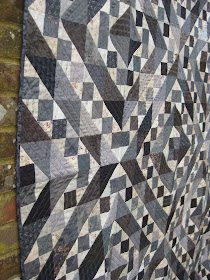Hello! Here is a fabulous Friday finish from my students, Miriam and Sophie. They have worked so hard over the past few months transforming a big bag of fabric squares which were no longer wanted and giving them new life as rainbow bunting.
The technique we used was the same as for my Vintage Bunting (tutorial in this post, there are a few unrelated quilt pics first so scroll down).

We worked out the best size for the pennants based on the amount of fabric available in each piece and the dimensions of the roll of Bondaweb (now called Vliesolinefix, I believe, but it will always be Bondaweb to me). Even though the fabric pieces were free, I wanted to maximise the amount we were able to use.
The squares varied a little in size but most could be folded in half to give four double sided pennants, each measuring 7" across the base (top) of the triangle by 11" long. We found that four pennants set 'head to tail' fitted perfectly across the folded fabric square and across the 18" width of a roll of Bondaweb.
(We made our pennant template from a sheet of A4 paper and just fiddled about until it fitted the fabric and looked a nice shape - you can make your pennant any shape or size you wish. Once you are happy with it, though, it is worth making a plastic template as this is much more robust to draw round than paper or cardboard).
So decisions made, the girls set to work and we set up a production line for all the processes. First task, to slice the roll of Bondaweb into 11" pieces (the roll is 18" wide) and for this we used a rotary cutter and ruler for speed and accuracy.
Then the fabric squares were pressed in half and the iron applied until the Bondaweb adhered to one half. When the paper had cooled and the glue set, the backing paper was peeled off and the top half of the fabric square flipped down and pressed to stick. Hey presto, a bonded double sided sheet of fabric, which could then be marked with the shape of the pennants and cut out.
We found that the easiest way to cut out the pennants was to mark the four triangle shapes on the fabric (arranged head to tail again) using the plastic template and either a pencil or chalk marker, and then to cut out with rotary cutter and ruler. This meant we had really accurate sharp edges to our pennants. I would not recommend you to use the template to cut against as it is not a safe method.

So each piece of fabric yielded four double sided pennants which then had to be zigzagged round the two long edges (not the base/top of the triangle as this will be covered by the tape). I think this was the task the girls liked least, but they became very good at it, including navigating round the narrow tip! I turned out my threads box to find colours which more or less matched the various shades across the rainbow.

Finally the preparation was done and the fun part could begin: Miriam and Sophie had glued, cut and stitched 288 pennants in total, four each of 72 different fabrics. They were keen to use a rainbow layout so they first arranged the pennants in bundles of four in graduating colour order.

Next the question of how many pennants to put in each string? After much deliberation and a bit of maths, it was decided to divide the pennants in to three different colour sets which would give 24 pennants per string, and there would be four strings of each colour set.

Once the decisions had been made, the pennants were sorted into their sets and the girls stitched them to the heading tape. Finally the task was complete! We didn't keep a note of how much time it took, and we have made other small projects in between, over the past three or four months, to keep from getting bored. Definitely worth it, though, I hope you will agree.

So twelve strings in all, each one a rainbow but subtle differences known only to the makers. Each string with 24 pennants measures about 4 1/2 metres in length. We used a total of 20.3 metres of bondaweb and 56.4 metres of tape. And we have about 54 metres of bunting in total - sufficient for most parties and the village fete!

All ready for the summer's events. There's nothing like a string of bunting to make us feel like we're having fun. And whilst this isn't exactly a free project (the Bondaweb and tape had to be purchased) the bunting is durable and should give many years of service.
Well done to the bunting makers: another skill to add to the CV. Linking to Finish it up Friday at Crazy Mom Quilts. Hope you have a happy and productive weekend, whatever you are working on.






























